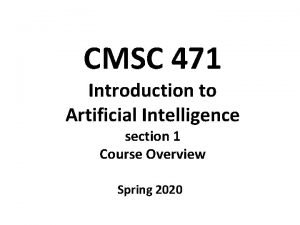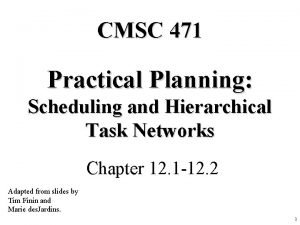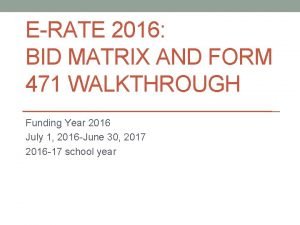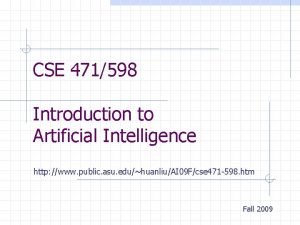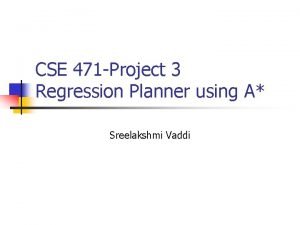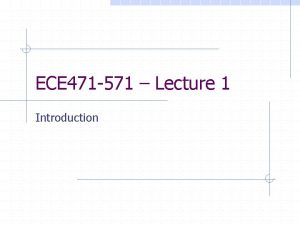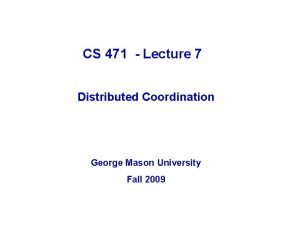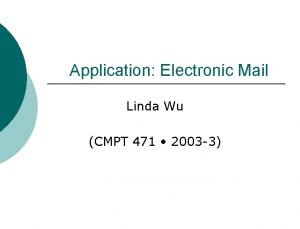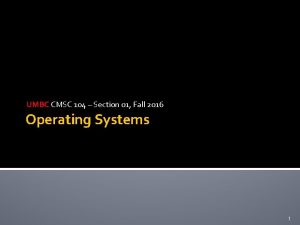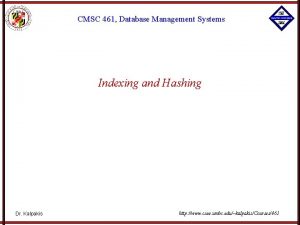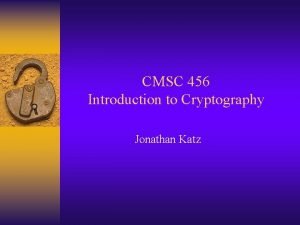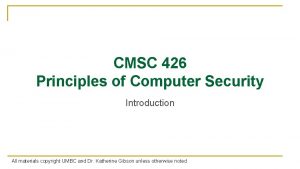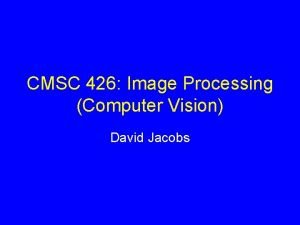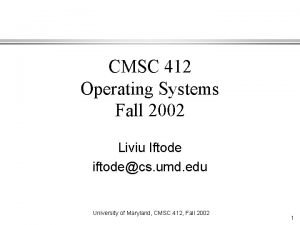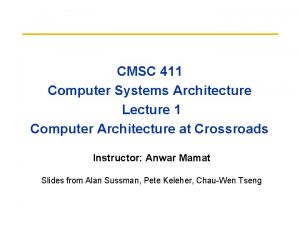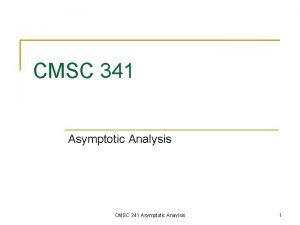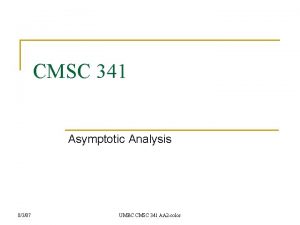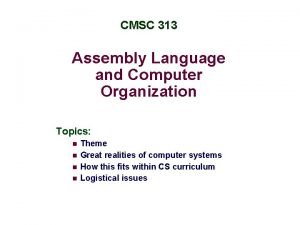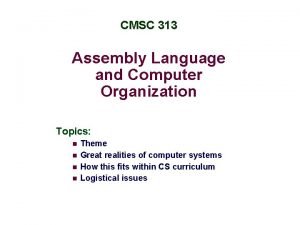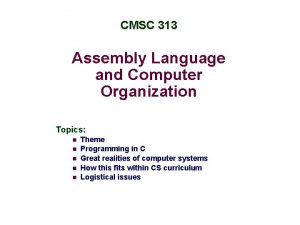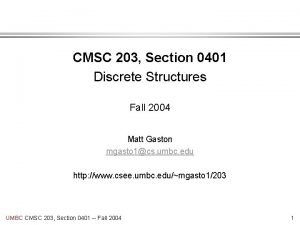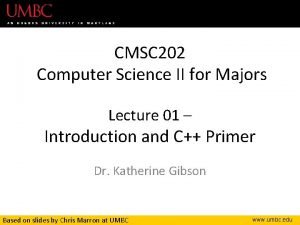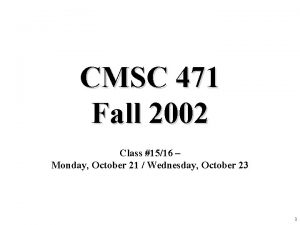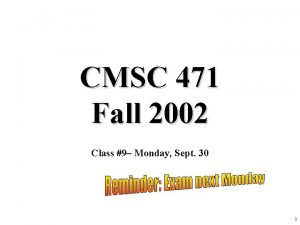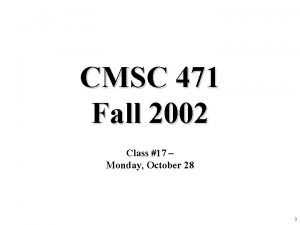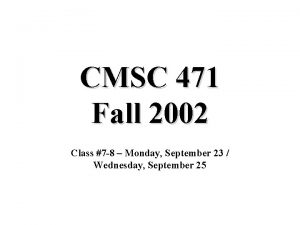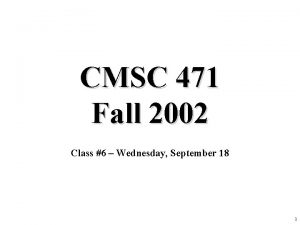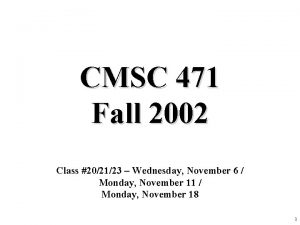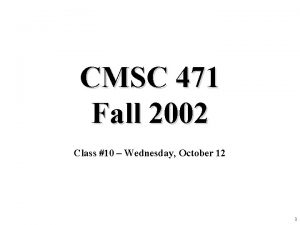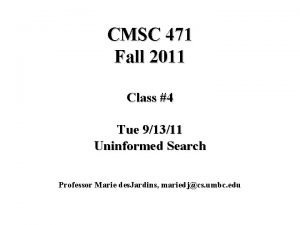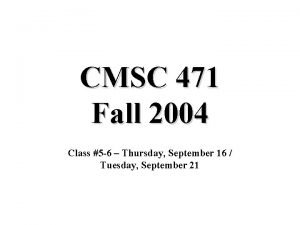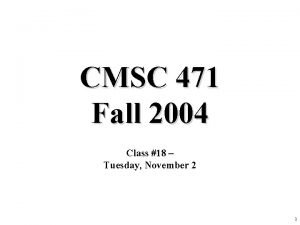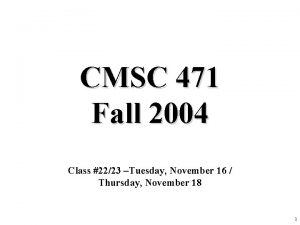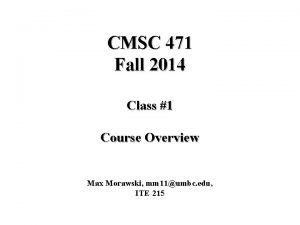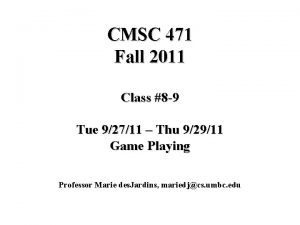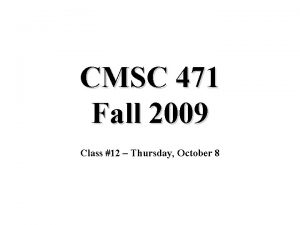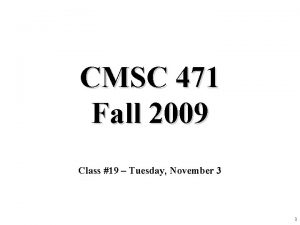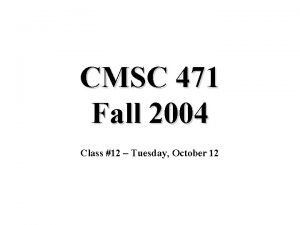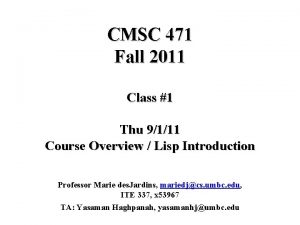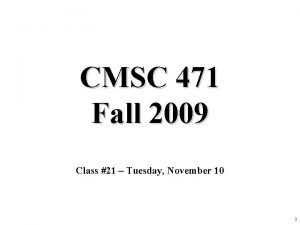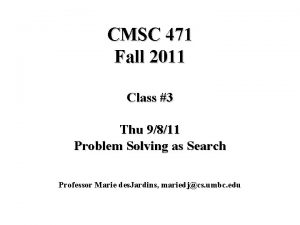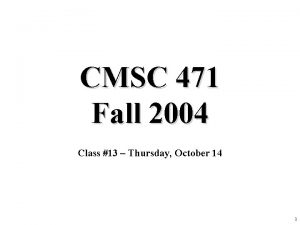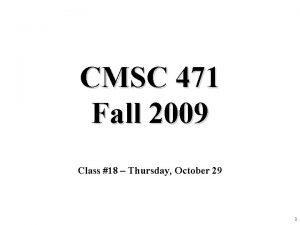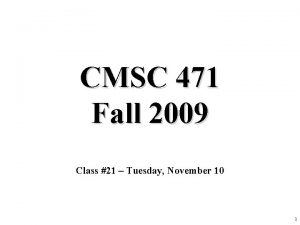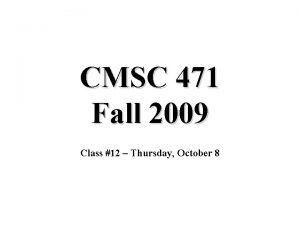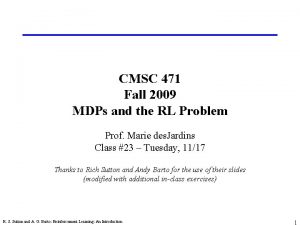CMSC 471 Fall 2002 Class 27 28 Monday































- Slides: 31

CMSC 471 Fall 2002 Class #27 -28 – Monday, December 2 / Wednesday, December 4 1

Today’s class(es) • Neural networks • Bayesian learning 2

Neural Networks / Bayes Net Learning Chapter 19 Some material adapted from lecture notes by Lise Getoor and Ron Parr 3

Neural function • Brain function (thought) occurs as the result of the firing of neurons • Neurons connect to each other through synapses, which propagate action potential (electrical impulses) by releasing neurotransmitters • Synapses can be excitatory (potential-increasing) or inhibitory (potential-decreasing), and have varying activation thresholds • Learning occurs as a result of the synapses’ plasticicity: They exhibit long-term changes in connection strength • There about 1011 neurons and about 1014 synapses in the human brain(!) 4

Biology of a neuron 5

Brain structure • Different areas of the brain have different functions – Some areas seem to have the same function in all humans (e. g. , Broca’s region); the overall layout is generally consistent – Some areas are more plastic, and vary in their function; also, the lower-level structure and function vary greatly • We don’t know how different functions are “assigned” or acquired – Partly the result of the physical layout / connection to inputs (sensors) and outputs (effectors) – Partly the result of experience (learning) • We really don’t understand how this neural structure leads to what we perceive as “consciousness” or “thought” • Artificial neural networks are not nearly as complex or intricate as the actual brain structure 6

Comparison of computing power • Computers are way faster than neurons… • But there a lot more neurons than we can reasonably model in modern digital computers, and they all fire in parallel • Neural networks are designed to be massively parallel • The brain is effectively a billion times faster 7

Neural networks • Neural networks are made up of nodes or units, connected by links • Each link has an associated weight and activation level • Each node has an input function (typically summing over weighted inputs), an activation function, and an output 8

Layered feed-forward network Output units Hidden units Input units 9

Neural unit 10

Model of a neuron • Neuron modeled as a unit j • weights on input unit i to j, wji • net input to unit j is: • threshold j • oj is 1 if netj > j 11

“Executing” neural networks • Input units are set by some exterior function (think of these as sensors), which causes their output links to be activated at the specified level • Working forward through the network, the input function of each unit is applied to compute the input value – Usually this is just the weighted sum of the activation on the links feeding into this node • The activation function transforms this input function into a final value – Typically this is a nonlinear function, often a sigmoid function corresponding to the “threshold” of that node 12

Learning rules • Rosenblatt (1959) suggested that if a target output value is provided for a single neuron with fixed inputs, can incrementally change weights to learn to produce these outputs using the perceptron learning rule – assumes binary valued input/outputs – assumes a single linear threshold unit 13

Perceptron learning rule • If the target output for unit j is tj • Equivalent to the intuitive rules: – If output is correct, don’t change the weights – If output is low (oj=0, tj=1), increment weights for all the inputs which are 1 – If output is high (oj=1, tj=0), decrement weights for all inputs which are 1 – Must also adjust threshold. Or equivalently asuume there is a weight wj 0 for an extra input unit that has o 0=1 14

Perceptron learning algorithm • Repeatedly iterate through examples adjusting weights according to the perceptron learning rule until all outputs are correct – Initialize the weights to all zero (or random) – Until outputs for all training examples are correct • for each training example e do – compute the current output oj – compare it to the target tj and update weights • Each execution of outer loop is called an epoch • For multiple category problems, learn a separate perceptron for each category and assign to the class whose perceptron most exceeds its threshold 15

Representation limitations of a perceptron • Perceptrons can only represent linear threshold functions and can therefore only learn functions which linearly separate the data: i. e. , the positive and negative examples are separable by a hyperplane in n-dimensional space 16

Geometry X • W - = 0 > 0 on this side < 0 on this side 17

Perceptron learnability • Perceptron Convergence Theorem: If there is a set of weights that is consistent with the training data (i. e. , the data is linearly separable), the perceptron learning algorithm will converge (Minicksy & Papert, 1969) • Unfortunately, many functions (like parity) cannot be represented by LTU 18

Learning: Backpropagation • Similar to perceptron learning algorithm, we cycle through our examples – if the output of the network is correct, no changes are made – if there is an error, the weights are adjusted to reduce the error • The trick is to assess the blame for the error and divide it among the contributing weights 19

Output layer • As in perceptron learning algorithm, we want to minimize difference between target output and the output actually computed activation of hidden unit j (Ti – Oi) derivative of activation function 20

Hidden layers • Need to define error; we do error backpropagation. • Intuition: Each hidden node j is “responsible” for some fraction of the error I in each of the output nodes to which it connects. • I divided according to the strength of the connection between hidden node and the output node and propagated back to provide the j values for the hidden layer: update rule: 21

Backprogation algorithm • Compute the values for the output units using the observed error • Starting with output layer, repeat the following for each layer in the network, until earliest hidden layer is reached: – propagate the values back to the previous layer – update the weights between the two layers 22

Backprop issues • “Backprop is the cockroach of machine learning. It’s ugly, and annoying, but you just can’t get rid of it. ” Geoff Hinton • Problems: – black box – local minima 23

Learning Bayesian networks • Given training set • Find B that best matches D – model selection – parameter estimation B Inducer E A C Data D 24

Parameter estimation • Assume known structure • Goal: estimate BN parameters q – entries in local probability models, P(X | Parents(X)) • A parameterization q is good if it is likely to generate the observed data: i. i. d. samples • Maximum Likelihood Estimation (MLE) Principle: Choose q* so as to maximize L 25

Parameter estimation II • The likelihood decomposes according to the structure of the network → we get a separate estimation task for each parameter • The MLE (maximum likelihood estimate) solution: – for each value x of a node X – and each instantiation u of Parents(X) sufficient statistics – Just need to collect the counts for every combination of parents and children observed in the data – MLE is equivalent to an assumption of a uniform prior over parameter values 26

Sufficient statistics: Example • Why are the counts sufficient? Moon-phase Light-level Earthquake Alarm Burglary θ*A | E, B = N(A, E, B) / N(E, B) 27

Model selection Goal: Select the best network structure, given the data Input: – Training data – Scoring function Output: – A network that maximizes the score 28

Structure selection: Scoring • Bayesian: prior over parameters and structure – get balance between model complexity and fit to data as a byproduct Marginal likelihood Prior • Score (G: D) = log P(G|D) log [P(D|G) P(G)] • Marginal likelihood just comes from our parameter estimates • Prior on structure can be any measure we want; typically a function of the network complexity Same key property: Decomposability Score(structure) = Si Score(family of Xi) 29

Heuristic search B B E A A E se r ) e A v ( e e R or c s Δ E B C C E Add (C) re o c Δs De let e. E Δs A cor e(A ) E A C B E A A C C 30

Exploiting decomposability B B E A A E se ) A ( e r sco C C E Add (C) re o c Δs De let e. E Δs A cor e(A ) To recompute scores, only need to re-score families that changed in the last move E De let e. E Δs A cor e(A ) A C B E A C 31
 Cmsc 471
Cmsc 471 Cmsc 471
Cmsc 471 Monday math class
Monday math class No class on monday
No class on monday Erate frn
Erate frn Cse 471 asu
Cse 471 asu Regression planner
Regression planner Cogulation cascade
Cogulation cascade Ece 471
Ece 471 Cse 571 asu
Cse 571 asu Ee 471
Ee 471 Cse 471
Cse 471 Cse 471
Cse 471 Cs 471 gmu
Cs 471 gmu Cmpt 471
Cmpt 471 Cmsc 104 umbc
Cmsc 104 umbc Cmsc 250
Cmsc 250 Cmsc 417
Cmsc 417 Cmsc 461
Cmsc 461 Cmsc 456
Cmsc 456 Cmsc 426 umbc
Cmsc 426 umbc Cmsc426
Cmsc426 Cmsc412
Cmsc412 Cmsc 411 umbc
Cmsc 411 umbc Cmsc 341
Cmsc 341 Cmsc 341 umbc
Cmsc 341 umbc Cmsc335
Cmsc335 Cmsc 313
Cmsc 313 Cmsc 313
Cmsc 313 Cmsc 313
Cmsc 313 Cmsc 203 umbc
Cmsc 203 umbc Cmsc 202 umbc
Cmsc 202 umbc
